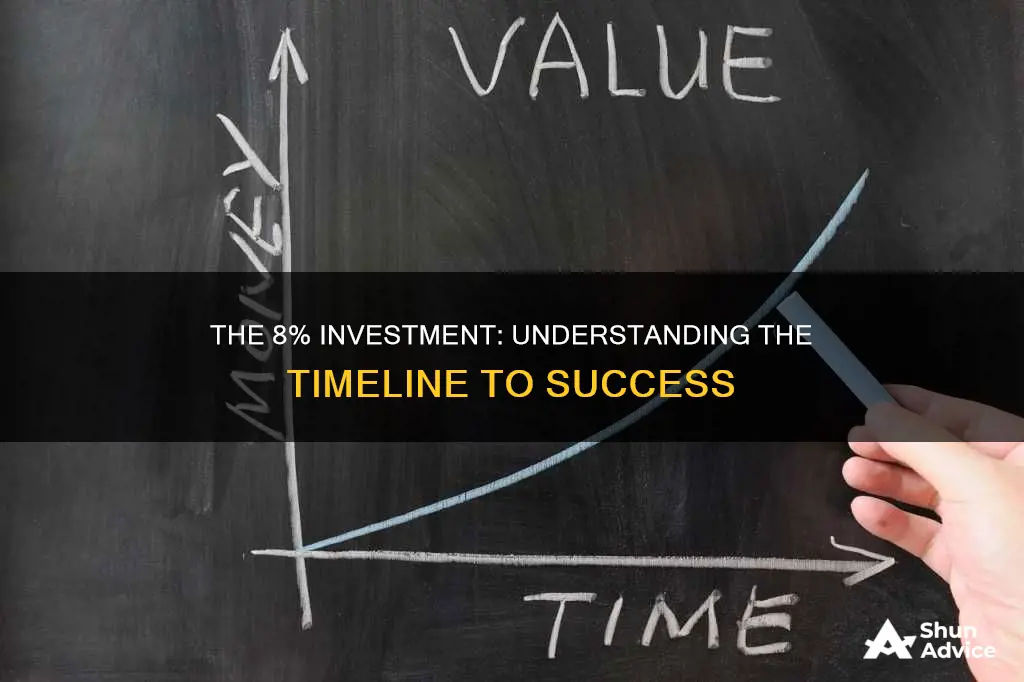
The Rule of 72 is a quick and useful formula that estimates how long it will take for an investment to double based on its rate of return. It is calculated by dividing 72 by the interest rate. For example, if an investment scheme promises an 8% annual compounded rate of return, it will take approximately nine years (72 / 8 = 9) to double the invested money.
The Rule of 72 is a simplified version of the compound interest formula, which is used to estimate the value of an investment after a specified period. Compound interest is interest that is earned not only on the initial amount invested but also on any further interest. In other words, compound interest is the interest on both the initial principal and the interest that has been accumulated.
| Characteristics | Values |
|---|---|
| Rule of 72 | 72 / 8 = 9 |
| Rule of 72 Formula | t = 72 / R |
| Rule of 72 Calculation | Divide 72 by the interest rate |
| Rule of 72 Application | Estimate how long it will take to double an investment at a given interest rate |
| Rule of 72 Accuracy | More accurate for interest rates between 6% and 10% |
What You'll Learn

The Rule of 72
For example, if an investment scheme promises an 8% annual compounded rate of return, it will take approximately nine years (72 / 8 = 9) for the initial investment to double.
The formula can also be used to estimate the rate of return needed for an investment to double within a given time period. For example, if you want to double your investment in 5 years, you would divide 72 by 5, which indicates that you would need to earn an annual interest rate of 14.4% (14.4 x 5 = 72).
While the Rule of 72 provides a quick estimate, it is important to note that it is not entirely precise. For more accurate calculations, investors can use the compound interest formula or tools like calculators and spreadsheet programs.
Maximizing an Inheritance: Strategies for Investing Toward Retirement
You may want to see also

Compound interest
The formula for calculating compound interest is:
= [P (1 + i)n] – P
= P [(1 + i)n – 1]
Where:
- I = annual interest rate
- N = number of compounding periods
For example, if you have a 3-year loan of $10,000 at a 5% interest rate, compounding annually, the amount of interest would be:
$10,000 [(1 + 0.05)³ – 1] = $10,000 [1.157625 – 1] = $1,576.25
The Rule of 72 is a simplified formula that can be used to estimate the number of years required to double an investment at a given interest rate. To use this rule, divide 72 by the interest rate to see how long it will take to double your money. For example, if you want to double an investment in 5 years, divide 72 by 5 to get the required interest rate of 14.4%.
The Rule of 72 is reasonably accurate for interest rates that fall between 6% and 10%. For rates outside this range, the rule can be adjusted by adding or subtracting 1 from 72 for every 3 points the interest rate diverges from 8%.
The number of compounding periods also makes a significant difference when calculating compound interest. The higher the number of compounding periods, the greater the amount of compound interest. For example, the amount of interest accrued at 10% annually will be lower than the interest accrued at 5% semi-annually for every $100 of a loan over a certain period.
Investor Priority: Peace of Mind
You may want to see also

Simple interest
The formula for calculating simple interest is:
Alternatively, this can be written as:
I = Total simple interest
P = Principal amount or the original balance
R = Annual interest rate
T = Loan term in years
Using this formula, you can calculate the number of years it will take for an investment to reach an 8% return. For example, if you invest $10,000 at an annual interest rate of 8%, you can calculate the time it will take to reach your desired return.
First, multiply the principal amount by the annual interest rate:
$10,000 x 0.08 (8%) = $800
Then, divide the desired return ($800) by the interest rate (8%) to get the time in years:
$800 / 0.08 (8%) = 10,000 years
So, it will take 10,000 years to reach an 8% return on a $10,000 investment at an annual interest rate of 8%.
You can also use the Rule of 72 to estimate how long it will take to double an investment at a given interest rate. The Rule of 72 states that you can divide 72 by the interest rate to find the number of years it will take to double your money. For example, at an 8% interest rate, it will take 72/8 = 9 years to double your investment.
It's important to note that simple interest is not commonly used in the real world, and even when people refer to 'interest', they usually mean compound interest, where interest is earned on the initial sum as well as on any accumulated interest.
Apple Investors: Who's Involved?
You may want to see also

Annual Percentage Yield (APY)
APY is calculated using the following formula:
APY = 100 [(1 + Interest/Principal)(365/Days in term) - 1]
Or
APY = (1 + r/n)^n - 1
Where:
- R = period rate
- N = number of compounding periods
The formula combines the interest rate and the frequency that it's applied. The more often interest is compounded, the higher the APY will be.
For example, a savings account with an 8% interest rate compounded monthly over 20 years without additional deposits will result in a final balance of $4,926.80 on an initial investment of $1,000. The total compound interest earned is $3,926.80.
APY is important because ignoring the effect of compounding may produce inaccurate expectations for important financial milestones. APY standardizes the rate of return and helps with financial projections. Understanding what APY is and how it's calculated may help improve financial literacy and enable more well-informed decisions about finances.
The Golden Age of Retirement Investing: Navigating the Sweet Spot
You may want to see also

Time value of money
The time value of money is a financial concept that underscores the notion that money in the present is worth more than an equal sum of money in the future. This is because money available in the present can be invested to generate a return, and thus, create a larger sum in the future.
Opportunity Cost
The time value of money is also related to the concept of opportunity cost, which is central to the principle of time value of money. Money can only grow if it is invested and earns a positive return. Therefore, a delayed investment is a missed opportunity.
Inflation
Inflation erodes the value of money over time. As prices rise, the purchasing power of money decreases. Thus, the future value of money is not the same as present-day dollars.
Rule of 72
The Rule of 72 is a simplified formula to estimate the number of years required for an investment to double based on its rate of return. It is calculated by dividing 72 by the interest rate. For example, an investment with an 8% annual compounded rate of return will take approximately nine years to double (72 / 8 = 9).
Calculating Future Value
The future value of a sum of money today is calculated by multiplying the amount of cash by a function of the expected rate of return over the expected time period. The formula for calculating the future value of an investment is:
> Future Value = Present Value x (1 + Interest Rate)^Number of Years
For example, if you invest $10,000 at a simple annual rate of 4.5% for three years, the future value of your investment at the end of the third year is $11,045.13.
Calculating Present Value
The present value of a future cash flow is calculated by dividing the future cash flow by a discount factor that incorporates the amount of time that will pass and expected interest rates. The formula for calculating the present value of a future payment is:
> Present Value = Future Value x (1 + Interest Rate)^(-Number of Years)
For example, if you expect to receive $10,000 in three years and the interest rate is 4.5%, the present value of the future payment is $8,762.97.
The time value of money is used to make strategic, long-term financial decisions, such as whether to invest in a project or which investment option is most favourable. It is also used in financial planning and risk management activities.
For instance, consider a scenario where you have won a cash prize and are offered two options:
- Receive $10,000 now
- Receive $10,000 in three years
If you choose option 1, you can invest the total amount at a simple annual rate of 4.5%. At the end of the first year, you will have $10,450. This amount, if left untouched and invested at the same rate for another year, would grow to $10,920.25 at the end of the second year. By the end of the third year, you would have $11,411.66.
On the other hand, if you choose option 2, you will only have $10,000 at the end of the three years. Therefore, option 1 is more favourable as it offers you $1,411.66 ($11,411.66 - $10,000) more in cash.
Compound Interest
It is important to note that the calculations above assume simple interest. In reality, most investments involve compound interest, where interest is earned not only on the initial amount invested but also on any interest accumulated. This means that interest earns interest, leading to exponential growth in the value of the investment over time.
The Great Debate: Mortgage vs. Investment — Where Should Your Money Go?
You may want to see also
Frequently asked questions
Using the Rule of 72, you can estimate that an 8% interest rate will double your investment in nine years (72/8 = 9).
With an 8% interest rate compounded monthly, you will earn $3,926.80 in compound interest over 20 years. Your final balance will be $4,926.80.
Simple interest is gained only on the principal amount, whereas compound interest is gained on both the principal amount and the interest accumulated from previous periods.
You can use the compound interest formula:
CI = P(1 + r/n)^nt – P
Where:
- CI = compound interest earned
- P = initial principal balance
- r = interest rate
- n = number of times interest compounds during each time period
- t = number of time periods







